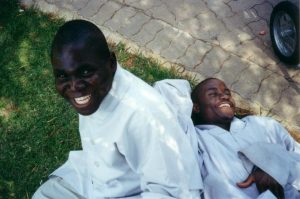Beginner’s Mind is a special project from BDG collecting insightful essays written by US college students who have attended experiential-learning courses related to Buddhism. Some of the authors identify as Buddhists, for others it is their first encounter with the Buddhadharma. All are sharing reflections and impressions on what they’ve learned, how it has impacted their lives, and how they might continue to engage with the teaching.
Emmy Austin wrote this essay for their Socially Engaged Buddhism course at the University of Southern California, a private university in Los Angeles. Emmy graduated from USC in August 2022 with a BA in East Asian Studies, with plans to move to Eugene, Oregon, to pursue a master’s in Social Work at Portland State University. Emmy is passionate about mental health and Korean cultural studies, and likes to read and play video games.

Finding My Path to Liberation
Last semester, I took REL331 Meditation and Healing in Buddhist Traditions because I had become interested in spirituality, and there were aspects of Buddhism that were attractive to me. Yet I felt uncomfortable practicing or following without a fully informed perspective on Buddhist culture, origins, issues, and so on. So, in that sense, last semester’s class was a great opportunity to learn about this history and build the foundation I needed to practice Buddhism honestly. Following on from that, however, REL342 Socially Engaged Buddhism has been completely different in that it has addressed some of my concerns that had developed throughout the previous semester.
Since we initially defined spiritual bypassing (using spiritual practices to avoid facing unresolved emotional or psychological issues), the concept has stayed with me and has been present in my mind ever since. Genuinely, I did not want to be the white person telling BIPOC to just “meditate and accept” a vicious reality, all the while co-opting Buddhism to do so. That form of Buddhism, which I feel is most common in secularized meditative retreats, completely centers on Whiteness and an absence of a marginalized reality. Meanwhile, I felt attracted to Buddhism for the opposite reasons: loving-kindness, doing good for others and myself, and a recognition of the interdependence of all living things.
Socially engaged Buddhism is a fantastic lens through which to view how Buddhism can be applied to “real life,” especially in terms of marginalization and/or oppression. It goes beyond following the Noble Eightfold Path, learning Pali terms, or reading the entire sutra canon. It’s about embodying the ideas of Buddhism personally for the liberation from suffering of all beings. It’s a way to be a bodhisattva right now. Buddhism can seem highly metaphysical when talking about the different buddhas and mystical figures, but through socially engaged Buddhism, we can become bodhisattvas in this life. This is why I find Buddhism so crucial to my activism now.
Locating a tradition or school of Buddhism with which I connect completely was and continues to be a struggle for me. I researched heavily, in and outside of class, seeking a place for my beliefs: Huayan, the Dalai Lama and Vajrayana, Zen, Nichiren, Vipassana . . . there are so many interpretations of the teaching and different kinds of teachers—in Los Angeles, I attended services and Dharma talks at the International Buddhist Meditation Center. Spiritual hierarchy always seems to be an issue for me, however. We debated this in REL331, but I concluded that wherever there is a distinct hierarchy or system of leadership, there will be an abuse of power. This was a disappointing outcome in many of my searches. At that point, I decided that there was no need to find my specific beliefs in a single tradition. I can practice and follow Buddhism as I see fit. I don’t feel the need to be an authority, or to listen to one, and that realization was relieving.
However, because of this Socially Engaged Buddhism class, I was able to explore a Buddhist movement that resonated with me; this movement is Radical Dharma.* I find it ironic that I bought this book only a month or two into the semester, but never found the time to read it. So when it actually became a part of my group project to do so, I was excited. The book is not organized like an omnipotent Bible. Instead, it’s a series of discussions involving long-term Buddhists and intrigued members of their communities. The audience contributes to the discussions as much as do the hosts.
While Rev. angel Kyodo williams is arguably the most central figure in the Radical Dharma movement, there is no sense of religious authority or hierarchy. It’s pure discussion and heart-to-heart conversations about how we can be better Buddhists for our communities and for our marginalized neighbors. This is the type of sangha in which I’m truly interested and about which I’m truly passionate. There is a line in the book by Rev. williams that summarizes exactly the type of Buddhism I follow:
We can’t just have our dharma practice in our living rooms and forget our high rents, forget landlords, and all of the things we have to pay for. We need to figure out how we just create the sangha wherever it is that we are.
While money is a significant stressor in most peoples’ lives, the use of it in this context can also be metaphorical. In our lifetimes, we have to pay with marginalization, trauma, illness . . . suffering. This we can’t just meditate away; we have to encompass and address it fully. That’s what Buddhism is to me, and what socially engaged Buddhism means.
Over the past year, I have learned much more about what being Buddhist truly means to me. If you had asked me this earlier, before I took these classes, my answer would have been very technical: follow the Noble Eightfold Path; learn and harness the Four Noble Truths; read the sutras; meditate and attend services. But these are only a fraction of the whole, stepping stones in the process. While I spent a few months doing those very things, my Buddhist journey of healing is far more than the rules and requirements of religious conversion. My journey has only just begun!
* Radical Dharma was first published as an edited volume and has now become the icon of a movement to actualize Buddhist spiritual equality into tangible social equality. For the book, see Williams, A. K., Owens, R., and Syedullah, J. Radical Dharma: Talking Race, Love, and Liberation. North Atlantic Books, 2016.
See more
Related features from BDG
The Path to Peace
Where I Am Now
Learning to Engage with Buddhism














